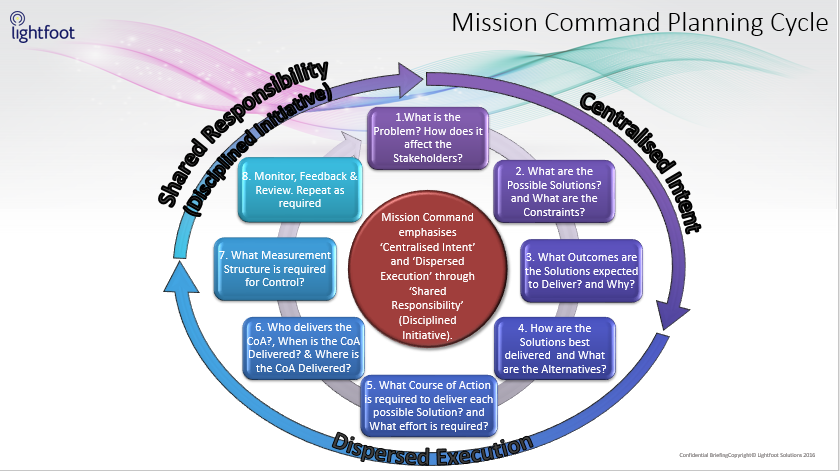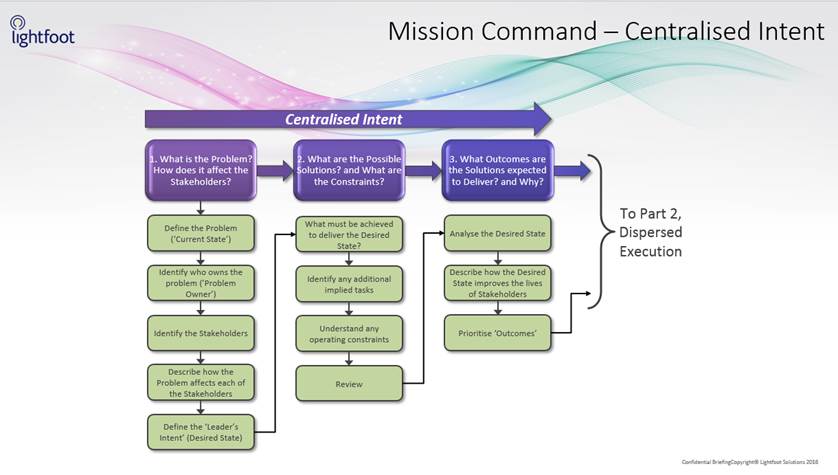Turn The Ship Around, Mission Command & Clarity (Part two from four)
09/04/2018


In the book “Turn The Ship Around” the author, David Marquet, tells us how important clarity is to implementing Mission Command. It is particularly important in the Centralised Intent stages of the 8-stage process:

And Stephen Bungay underlines this in his book Art of Action. In describing the “Knowledge Gap”, where Centralised intent is being developed, but with limited time, resources and data. We don’t like uncertainty, so many leaders follow a typically instinctive human reaction – get more data. This can delay Action, create over-complexity, paralyse decision-making – all of which lead to lack of simplicity and lack of clarity.
Instead it is better to shorten time-horizons, reduce scope or break down ambitions into more bite-sized chunks – so that what data we do have can be (largely) made sense of and distilled into a clear, simple Central Intent. In developing Central Intent, and pulling from work by Arnoud Franken (referred to in previous blogs), we can expand these three stages as follows:

So we’ll briefly explore the first of these 3 stages:
1. What is the Problem? How does it affect the Stakeholders?
a. Define the Problem (AS-IS State): Defining the Problem can take hours or days, and may be refined over some weeks. It should not be hurried, and should involve those close to the centre of the Problem to be Solved. Developing the Problem, whether it be the Top Team developing an Organisation’s Purpose or Project Leaders developing the Project’s Purpose, is as important as getting a clear, succinct, simple statement on paper. In this way, when others challenge the Problem Statement (and they surely will), those who have developed it and thought through all the angles, will be able to explain it in-depth and confidently, and if any holes are found, they treat this as learning, rather than to defend the Statement.
For example, working with a Public Sector organisation: “We do not understand the effect of demand on our capability to protect people, prevent crime, and deliver what we have promised to our Community”
b. Identify the Problem Owner: This usually runs through three levels – in understanding a Problem and developing a Purpose, you not only have to understand the Intent of your immediate boss, but the Intent of your boss’ boss.
For example, working with a Public Sector organisation: ACC sponsoring a project; Superintendent advocating and championing the project; Project Manager
c. Identify Stakeholders: The Stakeholder group will normally comprise:
i. those who enable the organisation, programme or project to go ahead, or who can stop it
ii. those who are customers / recipients of the output / outcome
iii. those who are designing / implementing this and the next stages (including external Partners if any) – i.e. Dispersed Execution
For example, working with a Public Sector organisation:
i. PCC & Chief Officers
ii. All front-line Officers and Staff
iii. Strategic R&A / Business Change / Project Team
d. How does the Problem affect Stakeholders: Having identified the Stakeholder groups, we then assess how the Problem manifests itself to them. Often this comes in the form of a reactive response:
i. Pressure to react to expectations of customers, media, community, political bodies, or regulators, and possibly inflict “Random Damage”*
ii. Pressure to propagate random damage
iii. Pressure to over-promise and under-deliver
For example, working with a Public Sector organisation
i. The problem creates a reactive state within the organisation leaving little capacity for considered action across our processes
ii. The problem creates a reactive state within the organisation leaving little capacity for considered action across our processes
iii. The problem creates pressure to “save the money” (take action without a desired level of planning & thought) / Pressure to deliver a coherent set of outcomes
e. Define Leaders’ Intent (TO-BE State): This will describe what “Good” looks like. It is important to spend some time on this element, since it is around this that we need high alignment.
For example, working with a Public Sector organisation: “Cohesively working together to achieve a goal. Manage the demand using a measured, systematic method. The project will have developed & demonstrated a method in an incident / crime type”
The crux is that in many organisations, high alignment vs high autonomy are intuitively seen as trade-offs. The learning we get from Stephen Bungay (when describing one of the most influential military leaders in the mid-late 1800s – Field Marshal Helmut Carl Bernhard Graf von Moltke) is that alignment and actions are different axes, and it is possible to have high alignment (of intent) and high autonomy (of actions).
More anon.
* Random Damage:
Random Damage was a term used in a global high-tech company (traded on the London Stock Exchange) where to make expected profit figures, if revenues were not high enough, then costs would be slashed across the board potentially damaging business processes and ultimately customer experience.
Categories & Tags:
Leave a comment on this post:
You might also like…
Keren Tuv: My Cranfield experience studying Renewable Energy
Hello, my name is Keren, I am from London, UK, and I am studying Renewable Energy MSc. My journey to discovering Cranfield University began when I first decided to return to academia to pursue ...
3D Metal Manufacturing in space: A look into the future
David Rico Sierra, Research Fellow in Additive Manufacturing, was recently involved in an exciting project to manufacture parts using 3D printers in space. Here he reflects on his time working with Airbus in Toulouse… ...
A Legacy of Courage: From India to Britain, Three Generations Find Their Home
My story begins with my grandfather, who plucked up the courage to travel aboard at the age of 22 and start a new life in the UK. I don’t think he would have thought that ...
Cranfield to JLR: mastering mechatronics for a dream career
My name is Jerin Tom, and in 2023 I graduated from Cranfield with an MSc in Automotive Mechatronics. Originally from India, I've always been fascinated by the world of automobiles. Why Cranfield and the ...
Bringing the vision of advanced air mobility closer to reality
Experts at Cranfield University led by Professor Antonios Tsourdos, Head of the Autonomous and Cyber-Physical Systems Centre, are part of the Air Mobility Ecosystem Consortium (AMEC), which aims to demonstrate the commercial and operational ...
Using grey literature in your research: A short guide
As you research and write your thesis, you might come across, or be looking for, ‘grey literature’. This is quite simply material that is either unpublished, or published but not in a commercial form. Types ...






